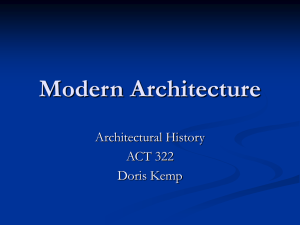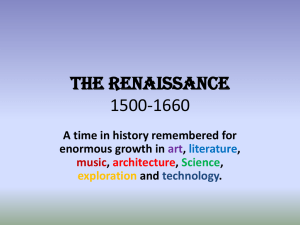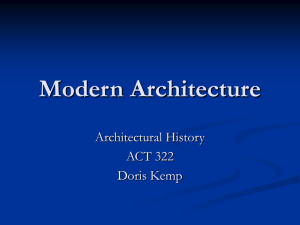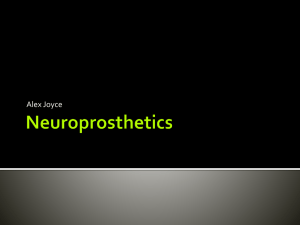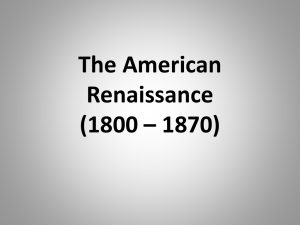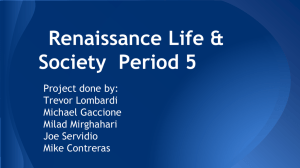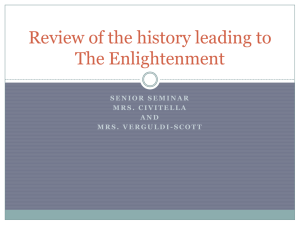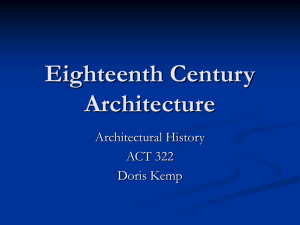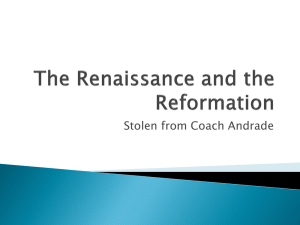The Late Renaissance
advertisement
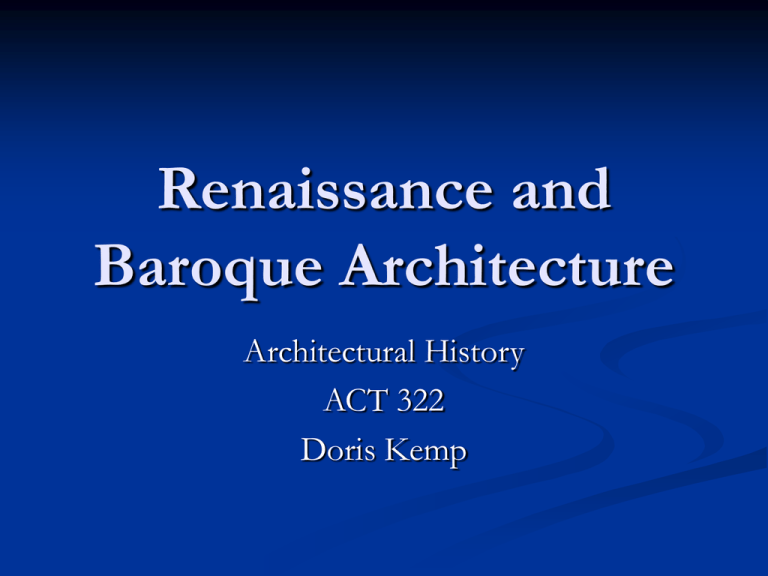
Renaissance and Baroque Architecture Architectural History ACT 322 Doris Kemp Topics Early Renaissance Filippo Brunelleschi Michelozzo di Bartolomeo Late Renaissance Giulio Romano Michelangelo Andrea Palladio The Early Renaissance Florence, Italy The birthplace of a new artistic movement called the Renaissance Led by rich merchants and leading trade guilds Not by religious figures as in medieval art A time of cultural excitement and discovery Creative talents of a group of young artists developed into a new artistic style The Early Renaissance Filippo Brunelleschi A great friend of Donatello Invented what is now called one- and two-point perspective A famous Italian sculptor The most realistic drawing technique used in design Responsible for many Italian Early Renaissance architecture designs The Early Renaissance Brunelleschi Cathedral of Florence Italian Gothic in style but absent of a flying buttress Used a ribbed structure to build a dome of some 150-ft at the diagonal Absent because local Italians believed this was of German decent and they wanted a pure Italian structure Larger than the Roman Pantheon, a great achievement for the time Brunelleschi had observed diagonal bonding in Roman ruins and used it to create the ribbed structure of the dome The Early Renaissance http://www.brynmawr.edu/Acads/Cities/wld/wdpt1.html The Early Renaissance http://www.brynmawr.edu/Acads/Cities/wld/wdpt1.html The Early Renaissance http://www.brynmawr.edu/Acads/Cities/wld/wdpt1.html The Early Renaissance http://www.brynmawr.edu/Acads/Cities/wld/wdpt1.html The Early Renaissance Brunelleschi Ospedale degli Innocenti (Founders Hospital) Expressed his empathy with ancient Rome with great detail in this structure Considered the first building of the Renaissance by many architectural historians Designed in 1419 and built from 1421 – 1444 Features a continuous arcade, carried on Corinthian columns across its main facade The Early Renaissance http://www.brynmawr.edu/Acads/Cities/wld/wdpt1.html The Early Renaissance http://www.brynmawr.edu/Acads/Cities/wld/wdpt1.html The Early Renaissance http://www.brynmawr.edu/Acads/Cities/wld/wdpt1.html The Early Renaissance Brunelleschi S. Lorenzo and S. Spirito, Florence Two of his larger structures in Florence Both featured a square bay aisle that defines a module repeated throughout the churches Both feature Roman elements within their interiors Semicircular arches Corinthian columns The Early Renaissance http://www.brynmawr.edu/Acads/Cities/wld/wdpt1.html The Early Renaissance http://www.brynmawr.edu/Acads/Cities/wld/wdpt1.html The Early Renaissance http://www.brynmawr.edu/Acads/Cities/wld/wdpt1.html The Early Renaissance Michelozzo di Bartolomeo A student of Brunelleschi A capable architect and was awarded several commissions Palazzo Medici One of his most notable designs Plan consists of a square with a central courtyard to serve as a circulation core for the perimeter rooms The Early Renaissance http://www.brynmawr.edu/Acads/Cities/wld/wdpt1.html The Early Renaissance http://www.brynmawr.edu/Acads/Cities/wld/wdpt1.html The Early Renaissance http://www.brynmawr.edu/Acads/Cities/wld/wdpt1.html The Early Renaissance Leone Battista Alberti A classical theorist who approached architecture as a way to express his philosophy of design Revised the De architectura libri decem (Ten Books on Architecture) Original manuscript written by the great Roman architect Marcus Vitruvius Completed his first version by 1452 Was circulated around Florence in 1485, after Alberti’s death The Early Renaissance Leone Battista Alberti S. Maria Novella, Florence Alberti designed the façade The first completed design for a church façade of the Renaissance Attempted to unify the façade by linking lower aisle roofs to the pedimented higher nave with flanking scrolls The Early Renaissance http://www.brynmawr.edu/Acads/Cities/wld/wdpt1.html The Early Renaissance http://www.brynmawr.edu/Acads/Cities/wld/wdpt1.html The Late Renaissance The Late Renaissance was not a stylistic period of concerted effort toward a definite goal Was a period of personal artistic expression Characteristics Disharmony Discord Imbalance Distortion The Late Renaissance Greatest designers of the period Michelangelo Buinarroti (1475 – 1564) Giulio Romano (1510 – 1580) Andrea Palladio (1508 – 1580) The Late Renaissance Giulio Romano Born in Rome Understood antiquity from a personal, intimate perspective rather than through education Most important structure Palazzo del Te The Late Renaissance Palazzo del Te Designed for Federigo II Gonzaga A honeymoon villa on an island at the edge of Mantua Originally conceived as an enormous stable complex Features Large, square courtyard enclosed on all four sides by a series of rooms Entrances centered on the north and east sides The Late Renaissance http://www.brynmawr.edu/Acads/Cities/wld/wdpt1.html The Late Renaissance http://www.brynmawr.edu/Acads/Cities/wld/wdpt1.html The Late Renaissance Michelangelo Widely regarded as one of the most creative geniuses in Western art Made important contributions to the fields of sculpture, painting, and architecture Important structures Capitoline Hill, Rome St. Peters, Rome The Late Renaissance Capitoline Hill Located in Rome Provided Michelangelo the opportunity to build a monumental civic plaza for a major city Located on the ancient seat of the Roman government Michelangelo redesigned most of the buildings in the site and continued working on it until his death The Late Renaissance http://www.brynmawr.edu/Acads/Cities/wld/wdpt1.html The Late Renaissance http://www.brynmawr.edu/Acads/Cities/wld/wdpt1.html The Late Renaissance St. Peters Michelangelo redesigned the church for a modern age Modified the dome to a hemispherical form Raised the exterior walls of the ambulatories Michelangelo died before much of the reconstruction was completed His design was followed until its completion in the 17th century The Late Renaissance http://www.brynmawr.edu/Acads/Cities/wld/wdpt1.html The Late Renaissance http://www.brynmawr.edu/Acads/Cities/wld/wdpt1.html The Late Renaissance Andrea Palladio Widely considered to be the most influential architects in western history Has had an impact on architecture in every century since his death (1580) Notable structures Villa Barbaro, Maser Teatro Olimpico The Late Renaissance Villa Barbaro Palladio designed this structure for a pair of aristocrats A vacation home Symmetrical scheme A center living structure balanced by end pavilions connected by flanking arcades Arcade’s openings provide space for farm equipment and animals The Late Renaissance http://www.brynmawr.edu/Acads/Cities/wld/wdpt1.html The Late Renaissance Teatro Olimpico Located in Vicenza Theatre Inspired by Roman theatres Roofed with a ceiling painted to depict the open sky http://www.brynmawr.edu/Acads/Cities/wld/wdpt1.html The Late Renaissance http://www.brynmawr.edu/Acads/Cities/wld/wdpt1.html References Sullivan, Mary; http://www.bluffton.edu/~sullivanm/ http://www.brynmawr.edu/Acads/Cities/wld/wdpt1.html Trachtenburg/Hyman; Architecture: From Prehistory to Postmodernity Wodehouse/Moffett; A History of Western Architecture Renaissance and Baroque Architecture Architectural History ACT 322 Doris Kemp
